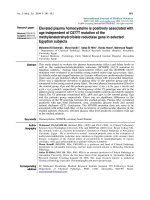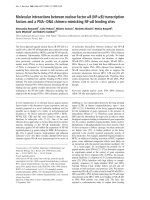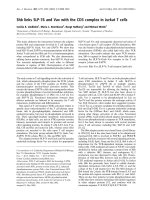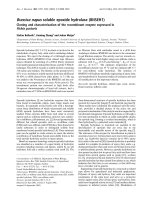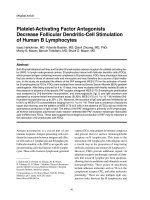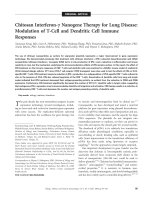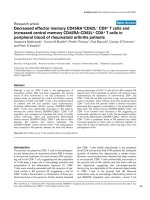Báo cáo y học: " Laypersons can successfully place supraglottic airways with 3 minutes of training. A comparison of four different devices in the manikin." docx
Bạn đang xem bản rút gọn của tài liệu. Xem và tải ngay bản đầy đủ của tài liệu tại đây (1.5 MB, 23 trang )
This Provisional PDF corresponds to the article as it appeared upon acceptance. Fully formatted
PDF and full text (HTML) versions will be made available soon.
Laypersons can successfully place supraglottic airways with 3 minutes of
training. A comparison of four different devices in the manikin.
Scandinavian Journal of Trauma, Resuscitation and Emergency Medicine 2011,
19:60 doi:10.1186/1757-7241-19-60
Gereon Schalte ()
Christian Stoppe ()
Meral Aktas ()
Mark Coburn ()
Steffen Rex ()
Marlon Schwarz ()
Rolf Rossaint ()
Norbert Zoremba ()
ISSN 1757-7241
Article type Original research
Submission date 18 August 2011
Acceptance date 24 October 2011
Publication date 24 October 2011
Article URL />This peer-reviewed article was published immediately upon acceptance. It can be downloaded,
printed and distributed freely for any purposes (see copyright notice below).
Articles in SJTREM are listed in PubMed and archived at PubMed Central.
For information about publishing your research in SJTREM or any BioMed Central journal, go to
/>For information about other BioMed Central publications go to
/>Scandinavian Journal of
Trauma, Resuscitation and
Emergency Medicine
© 2011 Schalte et al. ; licensee BioMed Central Ltd.
This is an open access article distributed under the terms of the Creative Commons Attribution License ( />which permits unrestricted use, distribution, and reproduction in any medium, provided the original work is properly cited.
1
Laypersons can successfully place supraglottic airways with 3 minutes of training.
A comparison of four different devices in the manikin.
Gereon Schälte
1
, Christian Stoppe
1
, Meral Aktas
2
, Mark Coburn
1
, Steffen Rex
1
, Marlon
Schwarz
1
, Rolf Rossaint
1
and Norbert Zoremba
1
1
Department of Anesthesiology, University Hospital Aachen, Aachen, Germany
2
Department of Pediatrics and Neonatology, University Hospital Aachen, Aachen, Germany
GS:
CS:
MA:
MC:
SR:
MS:
RR:
NZ:
Correspondence address:
Dr. med. Gereon Schälte, MA
Department of Anesthesiology
University Hospital Aachen
Pauwelsstr. 30
52074 Aachen
Germany
Fon: +49241800
Email:
2
Abstract
Introduction: Supraglottic airway devices have frequently been shown to facilitate airway
management and are implemented in the ILCOR resuscitation algorithm. Limited data exists
concerning laypersons without any medical or paramedical background. We hypothesized that
even laymen would be able to operate supraglottic airway devices after a brief training
session.
Methods: Four different supraglottic airway devices: Laryngeal Mask Classic (LMA),
Laryngeal Tube (LT), Intubating Laryngeal Mask (FT) and CobraPLA (Cobra) were tested in
141 volunteers recruited in a technical university cafeteria and in a shopping mall. All
volunteers received a brief standardized training session. Primary endpoint was the time
required to definitive insertion. In a short questionnaire applicants were asked to assess the
devices and to answer some general questions about BLS.
Results: The longest time to insertion was observed for Cobra (31.9 ± 27.9 s, range: 9-120,
p<0.0001; all means ± standard deviation). There was no significant difference between the
insertion times of the other three devices. Fewest insertion attempts were needed for the FT
(1.07 ± 0.26), followed by the LMA (1.23 ± 0.52, p>0.05), the LT (1.36 ± 0.61, p<0.05) and
the Cobra (1.45 ± 0.7, p<0.0001). Ventilation was achieved on the first attempt significantly
more often with the FT (p<0.001) compared to the other devices. Nearly 90% of the
participants were in favor of implementing supraglottic airway devices in first aid algorithms
and classes.
Conclusion: Laypersons are able to operate supraglottic airway devices in manikin with
minimal instruction. Ventilation was achieved with all devices tested after a reasonable time
and with a high success rate of > 95%. The use of supraglottic airway devices in first aid and
BLS algorithms should be considered.
3
Introduction
The securing of the airway and ventilation of the lungs is of paramount importance following
initial chest compressions during cardiopulmonary resuscitation (CPR). In the preclinical
setting, physical contact with the patient (in particular their mouth) presents a strong deterrent
to many lay responders. Disgust and fear of infection, associated with contact with bodily
fluids are frequently cited as preventing immediate care [1,2,3]. This may coincide with a fear
of incorrect mouth-to-mouth ventilation and potential malpractice consequences.
To facilitate mouth-to-mouth ventilation in case of out-of-hospital CPR several products are
available. These products are based on the principle of either covering the mouth and/or face
with a drape, or covering the nose and mouth via facemask with a mouth adapter. All devices
are equipped with a protective filter system. Achieving adequate ventilation (without gastric
inflation) is dependent on the seal of either face mask or drape, manual skills, and the
acceptance of close physical contact with a stranger and the associated risks [3]. Independent
of the type of device, it must be readily available, e.g. close to automatic external
defibrillators (AEDs), or carried in the pocket in readiness for emergencies.
For both junior and experienced medical personnel, supraglottic airway devices have
frequently been shown to facilitate airway management. Therefore, the laryngeal mask and
laryngeal tube are implemented in the American Society of Anesthesiologists (ASA)
algorithm for the management of the difficult airway and the International Liaison Committee
on Resuscitation (ILCOR) algorithm for cardiopulmonary resuscitation [4]. In both, manikin
and clinical studies, Paramedics, nurse and (para-) medical students have been shown to
secure the airway and ventilate the lungs faster and more effectively when using a supraglottic
airway device compared to mouth-to-mouth ventilation [5-8]. In a recently published study
we demonstrated that even without any instruction, first year medical students were able to
insert a supraglottic airway device intuitively with a reasonable speed and success rate. After
4
a minimal well directed training, insertion times and success rates can be markedly improved
[9].
We therefore hypothesized that even laypersons without any medical background would be
able to operate supraglottic airway devices following brief instruction.
The aims of this study were: 1) to test whether lay persons are able to secure the airway and
ventilate the lungs adequately using a supraglottic device following a brief training session of
3 minutes; and 2) to compare four supraglottic devices with regard to practicability:
Laryngeal Mask Classic® (LMA) and Laryngeal Mask Fastrach® (FT) (both: LMA
Deutschland GmbH, Bonn, Germany), Laryngeal Tube® (LT) (VBM Medizintechnik GmbH,
Sulz, Germany), CobraPLA® (Cobra) (Engineered Medical Systems, Indianapolis, IL, USA).
Methods
The institutional review board waived the requirement to obtain written informed consent
from the participants as no personal data except age and first aid knowledge were collected,
and no influence on the participants’ health was expected. All subjects agreed for their
performance to be evaluated and anonymously used for scientific and educational purposes.
Prerequisites for inclusion were the lack of any previous medical education (i.e. physician,
nurse, EMT, paramedic) other than a “first-aid” course, and an age of 16 or older.
Applicants were recruited in a public shopping mall and in the central cafeteria of the RWTH
Aachen University campus. Experimental data were recorded “on-site”.
Four different supraglottic airway devices (LMA, LT, FT and Cobra) were investigated. The
order in which devices were presented was rotated after every 35 participants to eliminate any
bias. A resuscitation scenario with a manikin (Ambu Airway Man®, Ambu GmbH, Bad
Nauheim, Germany) laying on the floor was prepared. All participants received a single
minimal standardized training session “hands off” before their individual trial. The
instructions comprised the following sentences: “This patient is in respiratory arrest. He has
5
stopped breathing and you must begin ventilation immediately. Much better and more
efficient than mouth-to-mouth ventilation is the use of one of these 4 devices (demonstrated).
Simply take one of them, insert it into the mouth of the patient, with the opening facing in the
same direction as the “belly button” until you feel resistance, connect the syringe, inflate the
balloon to form a seal (demonstrated with the LMA), connect the bag-valve and start to
ventilate the manikins lungs by compressing the bag gentle but full squeeze (two hands,
demonstrated). If the thorax does not expand and this indicator (shown) does not show green
or yellow, immediately take the device out, deflate the balloon, and start again
(demonstrated)”. The procedure was thus demonstrated step by step during the verbal
instructions. We chose the LMA for demonstration representing the eldest and most reviewed
modern supraglottic airway device. At the end the procedure was demonstrated again from
start to finish. Thereafter, no further questions were answered, nor was the demonstration
repeated on request. Immediately following insertion of the device a prepared syringe with the
designated correct air volume was connected, the cuff was inflated, and the time to first
manual ventilation was recorded. The volume of air inflated (Ambu Airway Man® scale) was
measured and any eventual leak estimated. The cuffs of all supraglottic devices were inflated
with the maximum volumes of air recommended by the manufacturer (LMA size 4 and FT
size 4 with 30 ml each, Cobra size 4 with 70 ml, and LT size 4 with 80 ml). A single trial was
aborted after 2 minutes or more than 3 failed attempts.
A tidal volume of >500ml was considered as sufficient according to the ERC resuscitation
guidelines. A tidal volume of less than <500 ml was deemed insufficient. An expiratory tidal
volume >800 ml was classed as no leakage, 500-799 ml as minor leakage and < 500 ml as
major leakage.
To eliminate the bias of a potential learning curve by the sequence supraglottic devices were
changed in random-order. None of the participants could watch the trial of any other
participator. Partition panels were used to separate and hide the resuscitation scenario.
6
At the end, individuals were asked which of the 4 devices they preferred. Finally 5 questions
concerning resuscitation had to be answered yes or no.
1. If emergency resuscitation kits including a bag-valve and a supraglottic airway device
were available in public places, e.g. sports facilities or at your workplace, do you
believe you would be able to use them to deliver adequate lung ventilation?
2. Do you believe that the combination of a supraglottic airway device and a bag-valve
can be used by lay responders during resuscitation reasonably?
3. Should this kind of lung ventilation be taught in first aid classes?
4. Do you think that this type of lung ventilation would make you more willing to deliver
lung ventilation during cardiopulmonary resuscitation?
Statistics:
A success rate of 95% was expected [10,11]. The power of the study was calculated with a
significance level, α = 0.05. The equivalence limit difference, d0 was assumed to be 7 and the
expected difference, d1 was set to be 0. A power of 80% results in a sample size of 120.
In total 141 study subjects were included to compensate for possible dropouts. The power
calculation was performed using nQuery Advisor
®
Version 7.0 (Statistical Solutions, Saugus,
MA, USA).
Statistical analysis was performed using GraphPad Prism 5.0 for Mac (GraphPad Software,
San Diego, CA, USA). Metric scaled data were analyzed calculating mean and standard
deviation. Analysis of variance (ANOVA) with Bonferoni correction for multiple
comparisons was used to detect statistical differences between the groups. To analyze the
variation in repeated measures of tidal volume, number of attempts, and time to insertion,
Friedmann’s test with Dunn’s correction was used. The level of significance was set at 5% for
7
these four variables. A P of ¼*5% = 0.0125 indicated statistical significance. A chi-square
test was used to detect statistical differences in contingent data.
Results:
Data from 141 subjects (65 women, 76 men) were analyzed. None of these had any previous
medical or paramedical education. In addition 19.1% (n=27) of these individuals had never
participated in a first-aid course, whereas a first aid course had been taken more than 10 years
ago in 13.5% (n=19), 2-10 years ago in 43.3% (n=61) and less than 2 years ago in 24.1%
(n=34) of the participants (Table 1).
Neither first-aid training itself nor how current this was correlated either with the time to
insertion (p=0.29) (Figure 1) or the number of attempts required (p=0.25) (Figure 2).
A comparison of the insertion times between the LMA, the LT, the FT and the Cobra devices
showed the Cobra to need the longest time for insertion (p<0.0001). No statistically
significant differences between the insertion times of the other three devices were found
Figure 3).
Regarding ease of insertion, the FT (1.07 ± 0.26) required fewest attempts, followed by the
LMA (1.23 ± 0.52), the LT (1.36 ± 0.61) and the Cobra (1.45 ± 0.7). No statistically
significant differences could be shown between the FT and the LMA (p>0.05). Compared to
the FT the Cobra (p<0.0001) and LT (p<0.05) required significantly more attempts for correct
placement, but no significant differences between the Cobra, LMA, and LT were found.
Significantly more patients were ventilated on the first attempt with the FT (p<0.001) (Table
2). No significant differences in the application of “sufficient” tidal volumes (> 500 ml) were
found among the 4 devices (p=0.08). Analysis of subgroups with tidal volumes of 500-800 ml
and >800 ml found significantly smaller (but sufficient) tidal volumes (500-800 ml) in LMA
8
ventilated patients (p<0.0001) (Figure 4). With all tested supraglottic devices a tidal volume
of more than 150 ml – the estimated dead space - could be generated (Figure 5).
In their statements evaluating the 4 devices subjects expressed a preference for the FT
(41.8%, n=59), followed by the LMA (34%, n=48), the LT (20.6%, n=29) and the Cobra
(3.5%, n=5). Commonly cited as supporting their classification were the ease of handling,
how intuitive they were to use, and their “grip”.
Failed insertions due to incorrectly rotated devices occurred 15 times. All of these occurred in
Cobra and on the 1
st
attempt (6x upside-down, p=0.67; 9x 180° dorso-ventral rotation & 1
combined upside-down, p=0.0024).
No bias of a potential “learning curve” by sequence of the supraglottic devices could be
demonstrated in terms time of insertion and number of attempts (Table 3).
Questionnaire: 67.4% of the participants felt competent in performing ventilation with a
supraglottic airway after this brief training, and 87.9% judged the combination of a
supraglottic airway and a bag-valve to be a useful aid in out-of-hospital resuscitation. Nearly
89.4% supported the introduction of and briefing with supraglottic airway devices in first-aid
courses. Finally, 85.8% agreed that the availability of these devices would make them more
likely to attempt ventilation during cardiopulmonary resuscitation.
Discussion:
In this manikin study, we show that laypersons are able to successfully place a supraglottic
airway following minimal training.
9
This ability was independent of prior first-aid education or its age. Despite the inherent
limitations of the scenario (plastic device inserted into plastic mannequin) and the limited
malleability of the “oral and supraglottic tissue” of the Ambu Airway Man®, we show that all
four supraglottic airway devices applied by laymen provided a reasonable airway and allowed
for the application of sufficient tidal volumes.
FT performed best with regard to time to insertion, number of attempts required, and in the
subjective assessments of the participants. Interestingly, none of the four devices tested
actually “failed”. A tidal volume of more than the assumed dead space (< 150ml) could
always be generated.
In contrast to previous studies, none of our volunteers had any healthcare training other than
first aid provider courses. We consider them therefore to act more intuitively and with a lower
level of caution than healthcare professionals, who are more familiar with and likely more
fearful of potential adverse effects.
Previous studies in patients, cadavers and manikin have all proven LMA, FT, LT and Cobra
to be efficient tools for airway management in the hands of naïve “intubators” and
inexperienced medical personnel [5,6,12-16]. These studies investigated first year medical,
paramedical and nursing students, as well as military personnel in combat paramedical or
medical education. In all these subjects we might assume a certain interest in, familiarity with
and aptitude for a range of medical procedures and emergencies. In addition, a current
certification in first-aid is a prerequisite for all such vocations (whereas it is not required to
hold a driving license, for example). Therefore, although not (yet) formally trained in
healthcare we might expect such subject populations to perform differently to “true
laypersons” as per our definition.
10
In the present study more than 58% of the participants had not attended a first aid course in
the past 2 years and 19% had no first aid training at all. (Only 23% of subjects had attended a
first–aid course within the past 2 years). Beauchamp et al. as well found a high success rate
independent from previous “first-aid” education [17].
To the best of our knowledge, this is the first study comparing several supraglottic airway
devices focusing on “true laypersons” without any background in healthcare, and in some
cases without basic first-aid training.
The participants in previous studies, in addition to a more healthcare oriented background,
also received a longer and more comprehensive training session prior to intonation. Few
studies have focused on the use of supraglottic airway devices by subjects having received
minimal training prior to intubation [9,18,19]. Jokela et al. used a short educational video-clip
for instruction and demonstrated that inexperienced first responder trainees could secure the
airway in a manikin with the FT and the LT with a comparable success rate [10]. In contrast,
we found a significantly better performance of laypersons operating the FT. A similar result
has previously been reported for paramedical students [20], non-anesthetic medical staff and
non-medical staff. [9,12,19].
Also in accordance with our results, the success rate for intubation attempts and the insertion
times for the COBRA device have previously been demonstrated to be lower than for other
devices, as well as being critically dependent upon operator experience [15].
The present study also observed another important problem with the COBRA-device: in 9
cases it was inserted 180° rotated, with the airway aperture dorsal instead of ventral. In the
Cobra, the airway aperture may be overseen due to the lack of curvature in the stem and the
fact that the aperture itself appears covered by some bars. Furthermore, the blocking balloon
encircles the distal part of the device. Consequently, the COBRA device performed worse
than the LM even when inserted by experienced anesthetists [13]. Although in our study an
11
attempted upside-down insertion of the COBRA-device was immediately recognized and
corrected by the participants, it remains questionable whether in the setting of a real
resuscitation lay responders under stress would act similarly. The difficulties described above
likely contribute to the participants estimation of the COBRA as the most difficult and
inconvenient device. The LT and FT were judged as most intuitive.
Success rates for the LT as observed in our study are similar to those reported in the literature.
Although Wrobel et al. indicated that lack of clinical experience could halve the initial
success rate when the LT is inserted by non-anesthesiologists, our results do not reveal such a
low success rate for the LT [21]. Similarly, in an out-of-hospital trial investigating LT airway
management by paramedics and emergency physicians, both performed equally well when
using the LT as a rescue device after failed endotracheal intubation or as an initial airway
[22]. The majority of users were relatively inexperienced, with less than 5 LT placements. In
accordance with our data first attempt success was about 78 %. Moreover, in undergraduate
students without medical training a high success rate of 80% for the King LT-D could be
demonstrated using “on-site” minimal scripted telephonic instruction [17].
In a manikin untrained laypersons can achieve a secured airway with the LMA or LMA-
classic even without detailed background knowledge about the tool. In fact, minimal
theoretical instruction and practical skill training significantly improved their performance
[9]. LMA supreme, in novice hands, systematically promoted easier ventilation of better
quality than the facemask in morbidly obese patients showing difficult mask ventilation
predictors [23]. The authors suggest that the LMA Supreme could be considered as a standard
airway management tool for both elective and rescue airway management. A 100% success
rate in manikin and a 64% success rate in the field among adult out-of-hospital non-traumatic
cardiac arrest have been reported in paramedics with manikin training only [20].
12
Timmermann et al. demonstrated that medical students could establish ventilation with the
intubation laryngeal mask significantly more successful and rapidly compared to bag-valve
ventilation in anesthetized patients [24]. In a single trial “mouth-to-mouth ventilation” via a
pocket face-mask was compared to the LMA provided by basic trained nurses. Success rate
were 51% for “mouth-to-mouth ventilation” via pocket-face-mask and 95% for the LMA
[11]. Recently Adelborg et al. proved “mouth-to-mouth” ventilation to reduce interruptions in
chest compressions and producing a higher proportion of effective ventilation during
lifeguard CPR, compared to “mouth-to-pocket-mask” or “bag-valve-mask” ventilation [25].
In consideration of these trials and acceptance of our results supraglottic airway devices might
be an excellent or even superior alternative to established ventilation provided by lay
responders.
We acknowledge that our study is subject to several limitations. Our results suggest that the
majority of supraglottic airway devices are well suited to use by laypersons. This might imply
in a preclinical emergency setting that laypersons, regardless of experience, can provide a
secured airway and hence bridge the time until a professional resuscitation team is on site. On
the other hand, it remains to be proven whether laypersons in a real resuscitation scenario,
with its associated challenges, can still rely on their intuition. Secondly, it is beyond the scope
of the present study to compare different educational modalities (classic, video, pictogram,
practical or combined) with regard to their effectiveness [14,20]. Thirdly, skills when newly
acquired and without subsequent practice are known to deteriorate [26], and it would
therefore be worthwhile re-evaluating all participants in the near future. Recent findings
however are promising: a single combined theoretical, video assisted and practical tutorial
enables paramedical students to operate different supraglottic airway devices in a mannequin
with retention of skills close to 100% after three months, even if no further clinical or manikin
training is provided [18,27].
13
Conclusion:
In conclusion, we show that in a manikin resuscitation scenario, airway management can be
safely and effectively performed by laypersons. The intuitive nature and ease of use of
supraglottic airway devices clearly leads to high success rates and this is one of their key
benefits. The present study shows that these benefits and success rates also extend to
members of the public without formal healthcare training, and even without any knowledge of
first-aid. Together with the positive attitude expressed by the participants towards such
devices, our results recommend the incorporation of supraglottic airway devices in first aid
and BLS courses.
Disclosure:
All authors declare not to have competing interests.
Authors’ contribution:
GS carried out conception and design, interpretation of data and drafted the manuscript. CS
and SR participated in interpretation and helped to draft the manuscript. MC and MS critical
revised the manuscript and supervised statistical analysis. MA allocated data and supervised
setting and participants. RR approved the final version and NZ co-conceived, critical revised
the manuscript and allocated data. All authors read and approved the final manuscript.
14
References:
1. Handley JA, Handley AJ. Four step CPR-improving skill retention. Resuscitation.
1998;36:3-8
2. Ornato JP, Hallagan LF, McMahan SB, Peeples EH, Rostafinski AG. Attitudes of
BCLS instructors about mouth-to-mouth resuscitation during the AIDS epidemic.
Ann Emerg Med. 1990;19:51-156
3. Brenner BE, Van DC, Cheng D, Lazar LJ. Determinance of refluctance of to perform
CPR among residents and applicants: the impact of experiences on helping
behaviors. Resuscitation. 1997; 35:203-211
4. Nolan JP, Soar J, Zideman DA, Biarent D, Bossaert LL, Deakin C, Koster RW, Wyllie
J, Böttiger B. European Resuscitation Council Guidelines for Resuscitation 2010.
Resuscitation. 2010 .
5. Choyce A, Avidan MS, Patel C, Harvey A, Timberlake C, McNeilis N, Glucksman E.
Comparison of laryngeal mask and intubating laryngeal mask insertion by the
naïve intubator. Br J Anaesth. 2000;84:103–105
6. Choyce A, Avidan MS, Shariff A, Del Aguila M, Radcliffe JJ, Chan T. A comparison of
the intubating and standard laryngeal mask airways for airway management by
inexperienced personnel. Anaesthesia. 2001;56:357–60
7. Timmermann A, Cremer S, Heuer J, Braun U, Graf BM, Russo SG. Laryngeal mask
LMA Supreme. Application by medical personnel inexperienced in airway
management. Anaesthesist. 2008;57:970–75
8. Heuer JF, Barwing J, Eich C, Quintel M, Crozier TA, Roessler M. Initial ventilation
through laryngeal tube instead of face mask in out-of-hospital cardiopulmonary
arrest is effective and safe. Eur J Emerg Med 2010;17:10-15
9. Bickenbach J, Schälte G, Beckers S, Fries M, Derwall M, Rossaint R. The intuitive
use of laryngeal airway tools by first year medical students. BMC Emerg Med.
2009;22;9:18
10. Jokela J, Nurmi J, Grenzwuerker HV, Castren M. Laryngeal tube and intubating
laryngeal mask insertion in a manikin by first-responder trainees after a short
video-clip demonstration. Prehosp Disaster Med. 2009;24:63-66
11. Alexander R, Chinery JP, Swales H, Sutton D. "Mouth to mouth ventilation": a
comparison of the laryngeal mask airway with the Laerdal Pocket Facemask.
Resuscitation. 2009 Nov;80:1240-3.
12. Burgoyne L, Cyna A. Laryngeal mask vs intubating laryngeal mask: insertion and
ventilation by inexperienced resuscitators. Anaesth Intensive Care. 2001;29:604–
608
13. Kurola J, Pere P, Nieme-Murola L, Silvast P, Rautoma P, Catren M. Comparison of
airway management with the intubating laryngeal mask, laryngeal tube and
CobraPLA® by paramedical students in anaesthetized patients. Acta Anaesthesiol
Scand. 2006; 50:40-44
14. Kurola J, Harve H, Kettunen T, Laakso JP, Gorski J, Paakkonen H, Silvast T. Airway
management in cardiac arrest - comparison of the laryngeal tube, tracheal
intubation and bag-valve mask ventilation in emergency medical training.
Resuscitation. 2004;61:149-53
15. Akca O, Anumpama W, Sengupta P, Durrani J, Hanni K, Wenke M, Yücel Y,
Lenhardt R, Doufas AG, Sessler DI. The new perilaryngeal airway (CobraPLA™) is
as efficient as the laryngeal mask airway (LMA™) but provides better airway
sealing pressure. Anesth Analg. 2009;99:272-8
15
16. Van Zundert A, Al-Shaikh B, Brimacombe J, Koster J, Koning D, Mortier E.
Comparison of three dispoable extraglottic airway devices in spontaneously
breathing patients. Anesthesiology. 2006;104:1165-1169
17. Beauchamp G, Phrampus P, Guyette FX. Simulated rescue airway use by
laypersons with scripted telephonic instruction. Resuscitation. 2009
Aug;80(8):925-9
18. Murray MJ, Vermeulen MJ, Morrison LJ, Waite T. Evaluation of prehospital
insertion of the laryngeal mask airway by primary care paramedics with only
classroom mannequin training. CJEM.2002;5:338-43
19. Levitan RM, Ochroch EA, Stuart S, Hollander JE. Use of the intubating
laryngealmask airway by medical and nonmedical personnel. Am J Emerg Med.
2000 Jan;18:12-6
20. Weksler N, Tamopolski A, Klein M, Schily M, Rozentsveig V, Shapira AR, Gurman
GM. Insertion of the endotracheal tube, laryngeal mask airway and oesophageal-
tracheal combitube. A 6-month comparative prospective study of acquisition and
retention skills by medical students. Eur J Anaesthesiol. 2005;22:337-40
21. Wrobel M, Grundmann U, Wilhelm W, Wagner S, Larsen R. Laryngeal tube versus
laryngeal mask airway in anaesthetised non-paralysed patientsA comparison of
handling and postoperative morbidity. Anaesthesist. 2004;53:702-8
22. Dengler V, Wilde P, Byhahn C, Mack MG, Schalk R. Prehospital airway
management of laryngeal tubes : Should the laryngeal tube Swith gastric drain
tube be preferred in emergency medicine? Anaesthesist. 2011;60:135-8
23. Abdi W, Dhonneur G, Amathieu R, Adhoum A, Kamoun W, Avenel A, Sebbah JL,
Combes X, Dhonneur G . LMA supreme versus facemask ventilation performed by
novices: a comparative study in morbidly obese patients showing difficult
ventilation predictors. Obes Surg. 2009 Dec;19:1624-30.
24. Timmermann A, Russo SG, Crozier TA, Eich C, Mundt B, Albrecht B, Graf BM.
Novices ventilate and intubate quicker and safer via intubating laryngeal mask
than by conventional bag-mask ventilation and laryngoscopy. Anesthesiology.
2007 Oct;107:570-6.
25. Adelborg K, Dalgas C, Grove EL, Jørgensen C, Al-Mashhadi RH, Lofgren B.
Resuscitation. Mouth-to-mouthventilation is superior to mouth-to-pocket mask
and bag-valve-mask ventilation during lifeguard CPR: a randomized study. 2011
May;82:618-22
26. Vertongen VM, Ramsay MP, Herbinson P. Skills retention for insertion of the
combitube and laryngeal mask airway. Emerg Med. 2003;15:459-64
27. Ruetzler K, Roessler B, Potura L, Priemayr A, Robak O, Schuster E, Frass M.
Performance and skill retention of intubation by paramedics using seven
different airway devices - a manikin study Resuscitation. 2011 May;82:593-7
16
Figure legends:
Figure 1: Time for insertion dependent on previous first aid education
No correlation was found between the time of insertion and the time passed since or no “first
aid” education (p=0.29). Data are presented as mean ± SD.
Figure 2: Number of attempts needed dependent on previous first aid education
No correlation was found between the number of attempts required and the time passed since
or no “first aid” education (p=0.25). Data are presented as mean ± SD.
Figure 3: Time of insertion dependent on the supraglottic device
Cobra needed the longest time for insertion (p<0.0001)*. No statistically significant
differences between the insertion times of the other three devices were found. Data are
presented as mean ± SD.
Figure 4: Number of attempts needed dependent on the supraglottic device
FT required the fewest attempts, followed by the LMA, the LT and the Cobra. No statistically
significant differences could be shown between the FT and the LMA (p>0.05). Compared to
the FT, the Cobra* (p<0.0001) and LT
#
(p<0.05) needed significantly more attempts for
correct placement. No significant differences between the Cobra, LMA, and LT were found.
Data are presented in percentage.
Figure 5: Applied tidal volumes dependent on the supraglottic device
No significant differences in the application of “sufficient” tidal volumes (> 500 ml) were
found among the 4 devices (p=0.08). Analysis of subgroups with tidal volumes of 500-800 ml
and >800ml found significantly smaller but sufficient tidal volumes (500-800 ml) in LMA*
ventilated patients (p<0.0001). Data are presented in numbers.
17
Tables section:
Table 1. Demographical data and previous first aid knowledge
Characteristics
Age, y 24.96±8 [16-73]
Sex
female, n 65
male, n 76
First aid education, n
no 27 (19.1%)
< 2 years 34 (13.5%)
2-10 years 61 (43.3)
> 10 years 19 (13.5%)
Data are presented as mean +/- standard deviation, [range], numbers and (percentage)
Table 2. Time of insertion, attemps and ventilation quality (tidal volumes, estimated leakage).
LMA Cobra LT
Time to insertion 23.8±21.2 (17) [9-120] 31.9±27.9 (19) [9-120] 21.9±14.7 (15) [8-75]
Success, n 138 (97.1%) 105 (95.8%) 139 (98.6%)
Leakage, tidal volumes
no, >800ml 36 (25.5%) 96 (68.1%) 97 (68.8%)
minor, 500-800ml 101(71.6%) 39 (27.7%) 42 (29.8%)
major, <500ml 4 (2.8%) 6 (4.3%) 2 (1.4%)
Attempts, %
1
st
/2
nd
/3
rd
80.9/14.9/4.3 66.7/22/11.3 71.6/21.3/7.1
Tidal volumes > 500ml were quoted sufficient according the ILCOR guidelines. With all devices a tidal volum
e greater than 150 ml (estimated dead space)
could be applied. Data are presented as mean +/- standard deviation, (median), [range] and number.
Table 3. Influence of sequence on insertion time and
number of attemps
Sequence 1 2 3 4 P value
Time [s]
LMA 28±21.4 19.7±15.8 25.3±25.9 22±21 0.36
Cobra 26.7±18.4 34.8±35.1 29.6±25.3 35.9±30.5 0.47
LT 19.6±13.4 20.74±19.9 23.4±13.9 23.8±17.4 0.57
FT 22.5±25.1 15.7±5.9 14.9±5.7 18.4±11.7 0.13
Attempts [n]
LMA 1.36±0.59 1.14±0.35 1.22±0.54 1.12±0.53 0.31
Cobra 1.37±0.59 1.45±0.78 1.37±0.59 1.58±0.77 0.52
LT 1.25±0.56 1.32±0.58 1.36±0.59 1.48±0.7 0.46
FT 1.02±0.35 1.02±0.16 1.02±0.16 1.08±0.28 0.19
No significant difference between LMA, Cobra, LT and FT regarding the sequence of use could be demonstrated
for the time of insertion or the attemps needed. Data are presented as means +/- standard deviation
Figure 1
Figure 2
Figure 3
Figure 4
Figure 5
